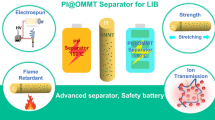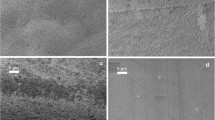Abstract
Battery separator is a porous membrane that is placed between the positive and negative electrodes to avoid their electric contact, while maintaining a good ionic flow through the liquid electrolyte filled in its pores. Non-woven mats have been evaluated as battery separators due to their highly porous structures. In this study, composite non-woven mats were fabricated through electrospinning and lamination with a ceramic layer, and evaluated as lithium ion battery separators. The lamination with the ceramic layer provides not only improved separator dimensional stability at elevated temperatures but also the potential to increase the production rate of electrospun separators. The electrospun mats keep ceramic particles from dropping avoiding the non-uniform current density distribution caused by the loss of the ceramic particles. The composite separators enabled good ionic conductivity when saturated with a liquid electrolyte. Coin cells with this type of separators showed not only stable cycling performance but also good rate capabilities at room temperature.







Similar content being viewed by others
References
Arora P, Zhang Z (2007) Battery separators. Chem Rev 104:4419–4462
Zhang SS (2007) A review on the separators of liquid electrolyte Li-ion batteries. J Power Sources 164:351–364
Huang X (2011) Separator technologies for lithium-ion batteries. J Solid State Electr 15:649–662
Munir MM, Suryamas AB, Iskandar F, Okuyama K (2009) Scaling law on particle-to-fiber formation during electrospinning. Polymer 50:4935–4943
Cho TH, Sakai T, Tanase S, Kimura K, Kondo Y, Tarao T, Tanaka M (2007) Electrochemical performances of polyacrylonitrile nanofiber-based nonwoven separator for lithium-ion battery. Electrochem Solid St 10:A159–A162
Cho TH, Tanaka M, Onishi H, Kondo Y, Nakamura T, Yamazaki H, Tanase S, Sakai T (2008) Battery performances and thermal stability of polyacrylonitrile nano-fiber-based nonwoven separators for Li-ion battery. J Power Sources 181:155–160
Croce F, Focarete ML, Hassoun J, Meschini I, Scrosati B (2011) A safe, high-rate and high-energy polymer lithium-ion battery based on gelled membranes prepared by electrospinning. Energ Environ Sci 4:921–927
Raghavan P, Manuel J, Zhao X, Kim DS, Ahn JH, Nah C (2011) Preparation and electrochemical characterization of gel polymer electrolyte based on electrospun polyacrylonitrile nonwoven membranes for lithium batteries. J Power Sources 196:6742–6749
Choi SW, Jo SM, Lee WS, Kim YR (2003) An electrospun polyvinylidene fluoride nanofibrous membrane and its battery applications. Adv Mater 15:2027–2032
Gao K, Hu XG, Dai CS, Yi TF (2006) Crystal structures of electrospun PVDF membranes and its separator application for rechargeable lithium metal cells. Mater Sci Eng B Adv 131:100–105
Zhu Y, Wang F, Liu L, Xiao S, Chang Z, Wu Y (2013) Composite of a nonwoven fabric with poly(vinylidene fluoride) as a gel membrane of high safety for lithium ion battery. Energ Environ Sci 6:618–624
Yang CR, Jia ZD, Guan ZC, Wang LM (2009) Polyvinylidene fluoride membrane by novel electrospinning system for separator of Li-ion batteries. J Power Sources 189:716–720
Lee YS, Jeong YB, Kim DW (2010) Cycling performance of lithium-ion batteries assembled with a hybrid composite membrane prepared by an electrospinning method. J Power Sources 195:6197–6201
Zhang SS, Xu K, Jow TR (2005) An inorganic composite membrane as the separator of Li-ion batteries. J Power Sources 140:361–364
Takemura D, Aihara S, Hamano K, Kise M, Nishimura T, Urushibata H, Yoshiyasu H (2005) A powder particle size effect on ceramic powder based separator for lithium rechargeable battery. J Power Sources 146:779–783
Cho TH, Tanaka M, Onishi H, Kondo Y, Nakamura T, Yamazaki H, Tanase S, Sakai T (2008) Silica–composite nonwoven separators for lithium-ion battery: development and characterization. J Electrochem Soc 155:A699–A703
Choi JA, Kim SH, Kim DW (2010) Enhancement of thermal stability and cycling performance in lithium-ion cells through the use of ceramic-coated separators. J Power Sources 195:6192–6196
Rao MM, Liu JS, Li WS, Liao YH, Liang Y, Zhao LZ (2010) Polyethylene-supported poly(acrylonitrile-co-methyl methacrylate)/nano-Al2O3 microporous composite polymer electrolyte for lithium ion battery. J Solid State Electr 14:255–261
Huang X (2011) Development and characterization of a bilayer separator for lithium ion batteries. J Power Sources 196:8125–8128
Min HS, Kang DW, Lee DY, Kim DW (2002) Gel polymer electrolytes prepared with porous membranes based on an acrylonitrile/methyl methacrylate copolymer. J Polym Sci Pol Phys 40:1496–1502
Tian Z, He XM, Pu WH, Wan CR, Jiang CY (2006) Preparation of poly(acrylonitrile-butyl acrylate) gel electrolyte for lithium-ion batteries. Electrochim Acta 52:688–693
Wu G, Yang HY, Chen HZ, Yuan F, Yang LG, Wang M, Fu RJ (2007) Novel porous polymer electrolyte based on polyacrylonitrile. Mater Chem Phys 104:284–287
Acknowledgments
The authors thank Yan Wu and Diane Feldkamp for providing the electrode materials and Jonathan Hitt for helping to set up the electrospinning apparatus. This work is supported by NSF CMMI-1030821.
Author information
Authors and Affiliations
Corresponding author
Rights and permissions
About this article
Cite this article
Huang, X., Bahroloomi, D. & Xiao, X. A multilayer composite separator consisting of non-woven mats and ceramic particles for use in lithium ion batteries. J Solid State Electrochem 18, 133–139 (2014). https://doi.org/10.1007/s10008-013-2254-5
Received:
Revised:
Accepted:
Published:
Issue Date:
DOI: https://doi.org/10.1007/s10008-013-2254-5




